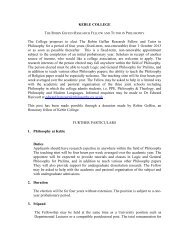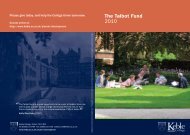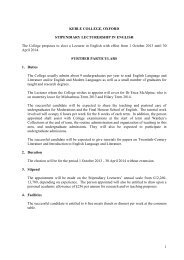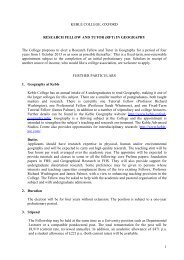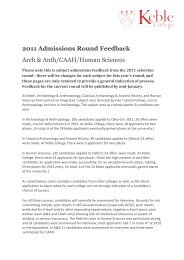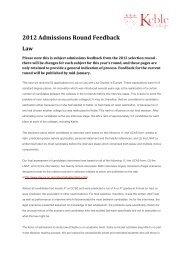The Record 2009 - Keble College - University of Oxford
The Record 2009 - Keble College - University of Oxford
The Record 2009 - Keble College - University of Oxford
Create successful ePaper yourself
Turn your PDF publications into a flip-book with our unique Google optimized e-Paper software.
<strong>Keble</strong> <strong>College</strong>: <strong>The</strong> <strong>Record</strong> <strong>2009</strong><br />
currents. <strong>The</strong> climate <strong>of</strong> Western Europe therefore depends<br />
indirectly on the mixing in these narrow straits.<br />
Since the real ocean contains overflows, and overflows are<br />
a crucial part <strong>of</strong> the Atlantic circulation, we obviously want<br />
the climate models which are being used for predictions <strong>of</strong><br />
climate change to include overflows too. However, overflows<br />
are very difficult to represent in large-scale computer models<br />
<strong>of</strong> the ocean, <strong>of</strong> the sort which are used (when coupled with<br />
atmospheric and ice models) to make climate predictions.<br />
<strong>The</strong>se models have grids with points only every 100km or<br />
so; the overflow straits are about this size or smaller, and the<br />
turbulence happens on even smaller scales. Climate models<br />
without proper overflows get the deep western boundary<br />
current all wrong, and so aren’t credible for understanding<br />
climate variations on the timescales (decades to centuries) when<br />
the ocean’s deep circulation comes into play.<br />
<strong>The</strong> Atlantic Meridional Overturning<br />
Circulation, after Rahmstorf, Nature<br />
1997<br />
For the past few years I have led a team <strong>of</strong> researchers from<br />
several different academic and research institutions spread<br />
over the USA, in an effort to improve the way in which<br />
climate models represent these overflows. <strong>The</strong> study <strong>of</strong> ocean<br />
circulation uses many different techniques — old fashioned<br />
laboratory experiments <strong>of</strong> the fundamental fluid dynamics,<br />
observations <strong>of</strong> the real ocean from ships and moored<br />
instruments, computer simulations <strong>of</strong> processes on many<br />
different spatial scales. Often, because <strong>of</strong> the different resources<br />
needed (e.g. ships versus computers) specialists in different<br />
techniques are located in different institutions — our team was<br />
put together to cross those disciplinary barriers and get us all<br />
working together on a common problem. All these different<br />
ways <strong>of</strong> looking at the problem are essential — for example only<br />
field observations can tell us what the real ocean is doing, but<br />
we can’t do experiments (i.e. changing the size <strong>of</strong> the straits,<br />
the density <strong>of</strong> the current) on the natural world, so that’s<br />
where the laboratory comes in. Some quantities are difficult to<br />
measure in the laboratory, and so computer models are useful<br />
there. But computer models don’t capture all the turbulence<br />
<strong>of</strong> the real ocean… and so on… After five years, we’re pleased<br />
that we have been able to combine new understanding<br />
from recent field campaigns and theoretical analysis <strong>of</strong> the<br />
rotating turbulent fluid dynamics with expertise in numerical<br />
algorithms to produce several improvements to our climate<br />
model representation <strong>of</strong> overflows. <strong>The</strong>se new models will be<br />
used in the next generation <strong>of</strong> climate simulations which will<br />
contribute to the next assessment <strong>of</strong> climate change by the<br />
Intergovernmental Panel for Climate Change.<br />
56



